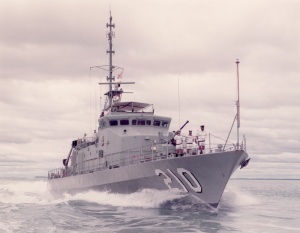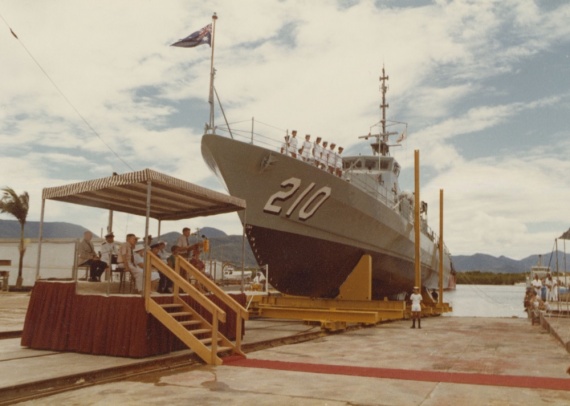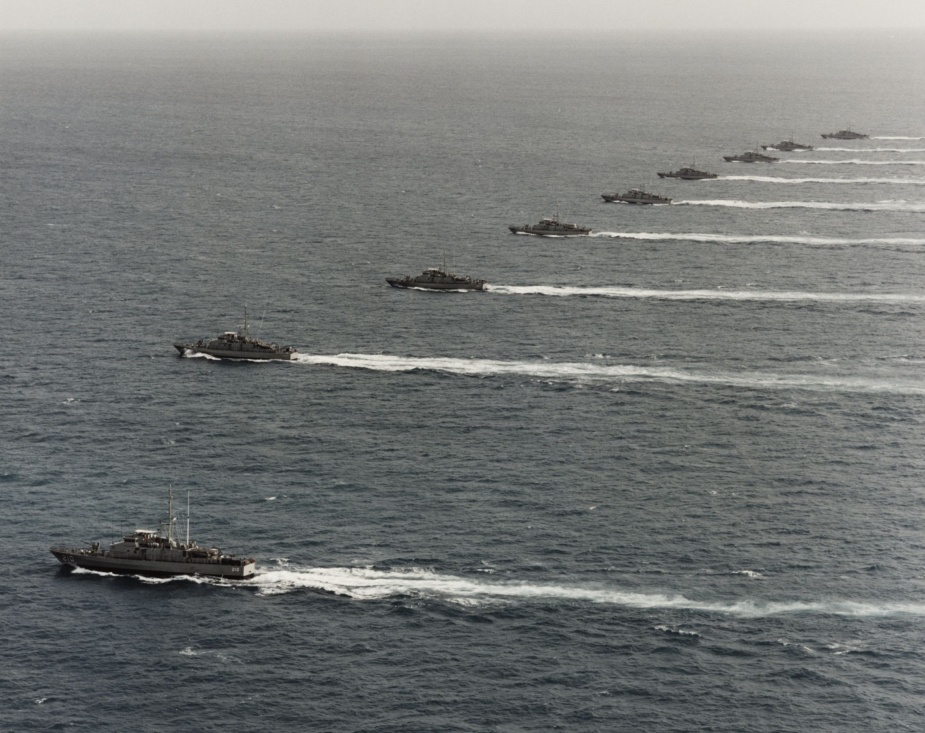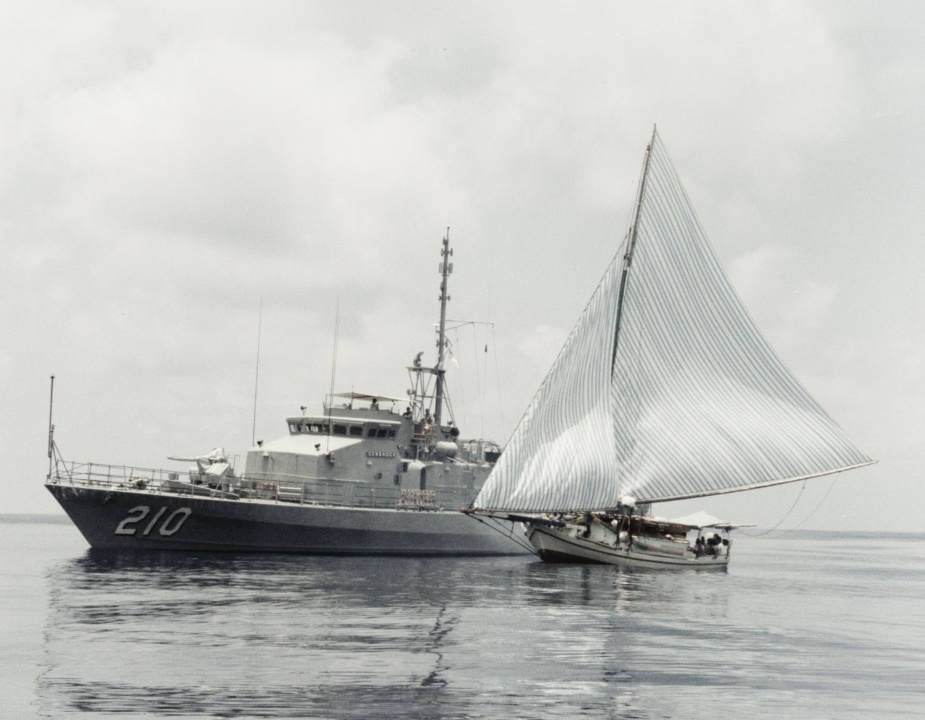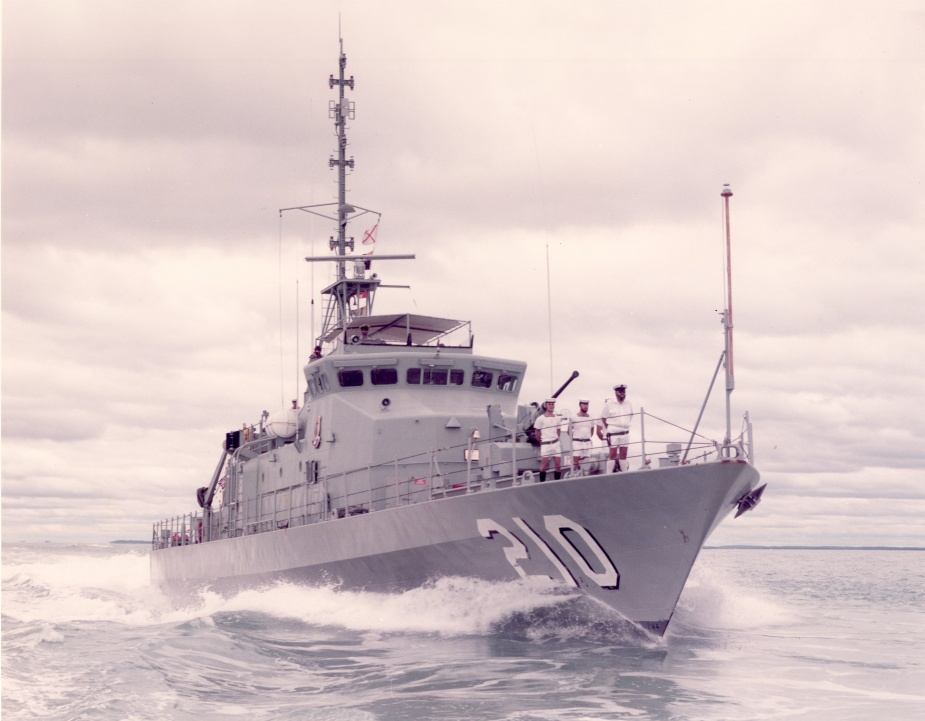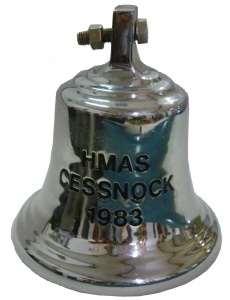HMAS Cessnock (II)
| Class |
Fremantle Class |
|---|---|
| Type |
Patrol Boat (PB) |
| Pennant |
P210 |
| Motto |
No Steps Backward |
| Builder |
North Queensland Engineers and Agents, Cairns, Queensland |
| Launched |
15 January 1983 |
| Launched by |
Lady Joan McNamara, wife of the Chief of Defence Force Staff |
| Commissioned |
5 March 1983 |
| Decommissioned |
23 June 2005 |
| Dimensions & Displacement | |
| Displacement | 220 tonnes |
| Length | 42 metres |
| Beam | 7.1 metres |
| Draught | 1.8 metres |
| Performance | |
| Speed | 30 knots |
| Range | 2360 nautical miles at 12 knots |
| Complement | |
| Crew | 24 |
| Propulsion | |
| Machinery |
|
| Horsepower | 6140 |
| Armament | |
| Guns |
|
| Other Armament | 1 x 81mm mortar |
| Awards | |
| Inherited Battle Honours | |
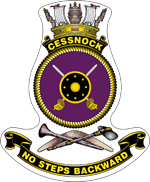
HMAS Cessnock was laid down at North Queensland Engineers and Agents, Cairns, Queensland and was launched on 15 January 1983 by Lady Joan McNamara, wife of the Chief of Defence Force Staff. She was the second RAN warship to carry the name of the city in the Hunter Region of NSW and is located about 52km by road west of Newcastle.
HMAS Cessnock commissioned at Cairns on 5 March 1983, the eighth of 15 Fremantle Class patrol boats built for the Royal Australian Navy between 1980 and 1984. She was also the seventh Australian built Fremantle Class patrol boat.
Following shakedown exercises in the Cairns area Cessnock arrived in her home port of Darwin on 19 April. The ship's company represented the RAN at Day services on Groote Eylandt, on a day that came to an unexpected end when the crew were recalled later that evening to assist local police search for a murder suspect who had put to sea in a trawler.
Cessnock sailed for her first fisheries patrol on 14 May 1983 and conducted her operational boardings two days later at Ashmore Reef. On 1 July Cessnock and HMAS Buccaneer fired a 15 gun salute to celebrate the fifth anniversary of Northern Territory self government. In September and October the ship participated in Exercise KANGAROO 83, returning to fishery patrols in November.
The year of 1984 commenced unusually for Cessnock when the ship was tasked to help the Australian Federal Police investigate into possible illegal diving activity on the wreck of the Japanese submarine I-124 that was sunk off Darwin in January 1942. She then deployed south to HMAS Stirling and Albany. March 1984 proved to be eventful with the ship avoiding Cyclone Kathy, which struck the Sir Edward Pellew group of islands. Cessnock proceeded direct to Alyangula to embark relief stores before sailing to the Pellew group for disaster relief operations, which included the recovery at sea of the only cyclone fatality.
In June 1984 Cessnock sailed from Darwin on her first overseas deployment, visiting Surabaya, Singapore and Jakarta; and joining Exercise STARFISH in the South China Sea. During the latter period of the year Cessnock was engaged on patrols off northern Western Australia.
Patrols for 1985 commenced in mid-January followed by exercises with the NORFORCE Koolan Island detachment in February. Two Indonesian fishing vessels were apprehended in early March 1985, although both were subsequently released without prosecution. Cessnock weathered Cyclone Gretel which passed over Darwin on 13 April and a week later sailed for Muara in Brunei. Cessnock and her sister ship HMAS Warrnambool continued on to Singapore where they joined HMAS Stuart for Exercise STARFISH.
Cessnock interrupted fishery surveillance operations in July 1985 to visit Exmouth for United States Independence Day celebrations at the Naval Communications Station, Harold E Holt. The following month Cessnock and her ship's company visited Broome for the Shinju Matsuri (Pearl Festival). Cessnock remained busy engaged on routine patrols in the final months of 1985 and boarded a number of Indonesian and Taiwanese fishing vessels.
The ship sailed on patrol in January 1986 and proceeded as far south as Stirling. In March Cessnock participated in Exercise HALLMARK and then sailed for Cairns to undertake her first refit. Cessnock was slipped at the North Queensland Engineers and Agents yard on 14 March, having steamed almost 103,000 nautical miles in her first three years of service. The refit was completed in late May and was followed by post refit workup exercises.
Cessnock arrived in Newcastle on 4 July and the ship's company paraded through the City of Cessnock the following day, having been granted Freedom of Entry. The ship then entered Sydney Harbour for the first time on 9 July before spending two weeks on patrol in Bass Strait.
Cessnock returned to her home port of Darwin in August 1986 after a five month absence and resumed normal patrol operations the following month, boarding 48 fishing vessels. On 11 October the ship hosted the First Sea Lord, Admiral Sir William Stavely, during his tour of Darwin Naval Base. Cessnock won the North Australia Area Task Unit Exercise Proficiency Shield and completed her patrol duties for 1986 in early December.
In January 1987 Cessnock battled heavy seas as she avoided two tropical cyclones. She rescued a resident of the Snake Bay Mission in February after he was stranded on South West Vernon Island. The following month Cessnock outpaced her Darwin based sister ships to win the Second Great Patrol Boat Race.
Cessnock sailed from Darwin on 12 April, rendezvoused with HMAS Wollongong in Brisbane, and both ships deployed in company for a six week deployment to the South West Pacific. Crew from Cessnock and Wollongong joined a contingent from HMAS Sydney for an Anzac Day march through Vila. Relief stores were embarked in Vila and all three ships proceeded to Tanna Island for disaster relief operations. Tanna Island bore the brunt of Cyclone Uma which caused considerable damage to Vanuatu in February 1987.
Following exercise PACIFIC GRANDEUR, Cessnock visited Fiji and Samoa. On 14 May, as Cessnock and Wollongong were en route to the Fijian port of Lautoka, news was received of the military coup led by Lieutenant Colonel Sitiveni Rabuka. On 15 May Cessnock and Wollongong berthed alongside HMAS Adelaide, which had arrived the previous day as the coup was taking place. The three ships spent the period of 15 to 20 May either alongside or at anchor in Lautoka Harbour, with only restricted leave granted due to the uncertainty of the situation ashore, before sailing in company to join HMA Ships Stalwart and Sydney south west of Fiji. The Australian task group patrolled off Fiji in support of Operation MORRIS DANCE, and stood by evacuate Australian nationals if required. The two patrol boats detached to return to Australia on 27 May, and Cessnock arrived back in Darwin, having steamed over 12,000 nautical miles on deployment.
After a month at Darwin, Cessnock commenced her second overseas deployment for the year in July, accompanying HMAS Gawler to Ambon, Brunei, Malaysia, Singapore and Indonesia; and participating in Exercise PENGUIN. Cessnock returned to patrol duty in September and conducted a one month intermediate docking before closing out a busy year with a post docking workup. During the workup, the ship was directed to assist and escort towards Darwin two Taiwanese pair trawlers that had allegedly been attacked in Indonesian waters and sustained damaged from small calibre weapons.
Australia's bicentennial year opened for Cessnock with a Coastwatch patrol of the north east coast of the Northern Territory. Cessnock departed Darwin in February for passage to Vanuatu where she would be based for six weeks to conduct surveillance operations on behalf of the Vanuatu Government as the patrol boat RVS Tukura was refitting in Townsville. The first task was to make Cessnock's presence known at as many harbours, ports and anchorages as possible after which the ship conducted disaster relief operations in the northern islands of Vanuatu which had suffered at the hands of Cyclone Anne the previous month.
In early March 1988 Cyclone Bola passed over the central Vanuatu islands, causing extensive damage. In conducting further disaster relief operations, Cessnock visited 30 villages on 11 islands and effected more than 200 beach landings to disembark stores and personnel. Back in Vila, the ship supported the Pacific Forum Surveillance Seminar before departing for the return passage to Darwin. Cessnock was subsequently awarded the Navy League of Australia Award for Aid to the Civil Community in recognition of her disaster relief operations.
Fishery patrols recommenced in May, and interspersed with planned maintenance periods, occupied the ship until October. Unfortunately the ship came off second best at Ashmore Reef, with the reef claiming two of Cessnock's anchors within the space of two months. The ship's company also experienced the first change of command outside of her home port of Darwin.
Cessnock sailed on 15 October for a planned circumnavigation of Australia, however, high seas off North West Cape and a tasking to search for, and subsequently apprehend a Type III Indonesian fishing vessel caused the cancellation of the circumnavigation. Cessnock proceeded to Newcastle in November to visit the City of Cessnock and exercise her right of Freedom of Entry. Cessnock's final commitment for 1988 was to visit to Port Moresby in December. During the return passage to Darwin the ship evacuated an injured fishermen off a Taiwanese trawler and transported him to Gove.
In March 1989 Cessnock apprehended the Thai stern trawler Prabdachai, and while later released, this led to the first occasion that a master of a Thai fishing vessel was prosecuted for fishing irregularities. Later that month Cessnock became the first Fremantle Class patrol boat to refit in Darwin. The refit was completed at the Frances Bay Slipway in May.
Successfully completing the obligatory post refit trials and workup exercises, Cessnock slipped back into the patrol routine and participated in Exercise KANGAROO 89 in August before deploying to Manus Island for celebrations marking the 10th Anniversary of Manus Province. His Excellency the Governor-General of Papua New Guinea embarked in Cessnock on 28 August for passage to Ponam Island and return. In September and October the ship accompanied HMAS Geraldton on a South West Pacific deployment to the Solomon Islands, Tuvalu (for the 11th Anniversary of Tuvalu Independence) and New Caledonia. During the last two months of 1989 Cessnock supported NORFORCE exercises and apprehended one foreign fishing vessel.
Cessnock commenced 1990 with an unsuccessful search in Beagle Gulf for three men lost overboard from the MV Desa and the following week was placed on standby for Operation DEFERENCE, a contingency plan to evacuate Australian nationals from the troubled island of Bougainville.
Routine patrols and planned maintenance occupied the ship until May 1990 when Cessnock sailed for the first of three overseas deployments within eight months. Between May and June Cessnock deployed to South East Asia and visited Indonesia, Malaysia, Singapore and Brunei. The highlight was the Royal Malaysian Navy International Fleet Review in Penang on 20 May.
Cessnock returned to Australia for only a short period before sailing for the South West Pacific islands of Vanuatu (to celebrate the nations 10th Anniversary of Independence), Tonga, Niue, Samoa, Tuvalu and the Solomon Islands. The ship returned for two months of patrol operations before departing Australian waters once again, this time to Papua New Guinea, thus completing her commitments for the year. An end of year highlight for Cessnock was the award of the Pakistan Shield for sporting prowess.
Between February and April 1991 Cessnock was actively engaged on fisheries patrol duties and she passed a significant milestone on 10 April 1991 when she steamed her 250,000th nautical mile. An Intermediate Docking in Darwin preceded a deployment to Indonesia and Papua New Guinea. The passage from Balikpapan to Wewak allowed the ship to perform fuel consumption trials on her newly installed Mk 5 propellers.
In September 1991 Cessnock set a new ship record, steaming 6,082 miles in the month. The last few months of the year were taken up with patrol duty and a leave period. Cessnock was assigned operational response vessel duties for the Christmas/New Year period, and the ship's company was recalled late on Christmas Day following a report of illegal fishing activity in Beagle Gulf.
Cessnock apprehended three fishing vessels during the first patrol of 1992 and in early March she participated in the month long Exercise KANGAROO 92. Following routine surveillance operations in April and May, the ship's company was given a days notice on 9 June to deploy Cessnock to Indonesia in lieu of HMAS Launceston. She accompanied HMAS Bunbury to Bali, Belawan and Sabang, and both ships exercised with their Indonesian counterparts.
On the return passage from Indonesia, Cessnock paid only her second operational visit to Christmas Island - the first had taken place eight years earlier. Cessnock supported Darwin Navy Week activities in mid-July and was actively engaged patrolling the Australian Fisheries Zone until late November.
1993 began quietly for Cessnock, with only a short period spent on patrol before she was due to slip at Darwin Ship Repair and Engineering for refit. The major highlight was Cessnock's 10th birthday on 5 March 1993, which the ship's company duly celebrated escorting the liner Queen Elizabeth II into and out of Darwin Harbour.
Her refit complete, Cessnock sailed for a workup and short patrol in July and proceeded in company with HMAS Bendigo to the Indonesian ports of Ujung Pandang and Surabaya in late August. Cessnock then participated in Exercise STARFISH in the South China Sea and returned to Australia via Singapore and Ujung Pandang, remaining in Australian waters until the close of 1993. Cessnock was awarded the 1993 Silver Platter in the minor war vessel category when the annual fleet awards were announced in December.
Cessnock resumed seagoing operations in late January 1994, spending one month on patrol during which an apprehended vessel sank under tow, and heavy seas whipped up by a tropical depression necessitated an enforced week long stay in Napier Broome Bay. In March Cessnock was employed for four days supporting the production of a training film on foreign fishing vessel boarding operations.
In April the ship conducted an Australian Customs barrier patrol and proceeded to Ambon for Anzac Day in support of the annual Gull Force Association Pilgrimage. The following month Cessnock visited the Indonesian ports of Ujung Pandang and Kupang in company with HMAS Geelong. A programmed deployment to the South West Pacific was cancelled due to a defect in the starboard generator. The defect was repaired in sufficient time to allow Cessnock to participate in a ceremony officially opening the new Northern Territory Parliament House on 18 August.
On 22 September Cessnock and Wollongong were ordered to sea following a report that 27 Indonesian fishing vessels had been sighted in the vicinity of Ashmore Reef. The two patrol boats boarded and apprehended twelve fishing vessels the following evening as the small fleet doused their navigation lights and scattered in all directions in the darkness to avoid capture. Each patrol boat towed six fishing vessels to Broome and handed them over with about 116 fishermen to the detention centre at Willie Creek.
Cessnock returned to Ashmore Reef on 28 September and apprehended a further thirteen Indonesian fishing vessels over a period of nine hours. Following attempts by most to cut loose their tow lines and escape in the early hours on 29 September, eleven were successfully rounded up in the darkness and taken in tow to Darwin, with assistance provided by the Australian Customs Vessel ACV Austin Chapman and HMAS Launceston.
Illegal fishing activity did not let up and Cessnock apprehended another three vessels in October; and one Taiwanese longliner and eight Indonesian vessels in November. She also embarked a 60 Minutes film crew producing a segment on Indonesian fishing activity.
Cessnock had further success in Australia's Economic Exclusion Zone in the early months of 1995 and was involved in the transfer of five Afghani nationals that had landed at Ashmore Reef. In late March she participated in the latter stages of Exercise KAKADU II before celebrating Anzac Day for the second consecutive year in Ambon.
Cessnock entered an extended maintenance period in mid 1995 and completed her workup before spending three weeks actively engaged in Exercise KANGAROO 95 which was held in August. In September Cessnock and Launceston paid a short visit to Kupang; and in October she conducted Exercise SPIDERMAN with the Pilbara Regiment. The year concluded with the Minor War Vessel Concentration Period.
After two months alongside, Cessnock sailed on 12 February 1996 for South East Asia. In addition to calling at ports in Indonesia and Malaysia, the deployment was noteworthy in that the ship paid its first ever visit to the Philippines.
In May 1996 Cessnock and HMAS Bendigo visited Kupang and embarked a joint Australian/Indonesian delegation that was negotiating the seabed boundary between the new nations. The delegation was transferred to and from Ashmore Reef. Cessnock returned to Kupang in June on completion of Exercise CASSOWARY. Cessnock started the Darwin to Ambon Yacht Race on 27 July 1996 and participated in the Fleet Concentration Period in August.
Between the months of September and December 1996, Cessnock apprehended 11 foreign fishing vessels and transferred a group of illegal immigrants from Ashmore Reef to the mainland. In mid-December she proceeded to Exmouth Gulf to be on standby for an Australian Federal Police tasking before transiting back to Darwin.
On 3 January 1997 the ship's company was recalled so that Cessnock could sail to ride out Cyclone Rachel. A rare opportunity arose on 7 January when Cessnock and Wollongong conducted a passage exercise with the visiting Italian warships Durand De Le Penne and Bersagliere. Both patrol boats accompanied each other on a short South East Asian deployment in March, beginning with a visit to the Balinese port of Benoa to facilitate a tour by the Indonesian Chief of Naval Staff. They then proceeded to Puerto Princesa in the Philippines, the southern Thai border province of Songkhla, and Jakarta.
Between May and August 1997 Cessnock was refitted by Darwin Ship Repair and Engineering and sailed on patrol on 29 September. Despite spending very little time on patrol in 1997, Cessnock finished the year on a high, apprehending 13 foreign fishing vessels in November, one of which valiantly attempted to resist boarding, and helped her sister ships tow another four into port.
Cessnock's first patrol of 1998 commenced on 16 January and was plagued by marginal weather and uncomfortable seas. She rode out gale force winds at Broome that were whipped up by Cyclone Tiffany and encountered heavy seas generated by Cyclone Les. On 23 February 1998 Cessnock departed on an eight week South West Pacific deployment in company with HMAS Dubbo. They visited Indonesia, Palau, Micronesia, the Marshall Islands, Kiribati, Vanuatu and New Caledonia. In mid May Cessnock ship conducted Operation SOUND ONE, a coordinated Coastwatch surveillance operation in King Sound.
Cessnock spent the second half of 1998 on patrol in Australian waters. She was the subject of national media attention following two high profile incidents in July. The first occurred on 7 July when an Indonesian Ice Boat refused to heave to, despite the warning shots that were fired across her bow, and then deliberately collided with Cessnock causing superficial damage. An unsuccessful hot pursuit ensued. During the middle watch of 22 July another fishing vessel, under escort to Darwin, unexpectedly veered across Cessnock's bow in the darkness and sank after the unavoidable collision.
In December Cessnock was ordered to proceed to Stirling in company with HMA Ships Gawler, Launceston and Wollongong to avoid Cyclone Thelma. This was Cessnock's first visit to Stirling since January 1986.
In March 1999 Cessnock boarded a suspected illegal entry vessel, with 16 foreign nationals on board, off Christmas Island. In April she accompanied HMAS Bendigo on a short deployment to Indonesia, visiting Ujung Pandang and supporting the Anzac Day services at Ambon. In May Cessnock returned to patrol duty and supported by two of her sister ships, evacuated to Darwin 54 illegal immigrants who had been deposited at Ashmore Reef. Later in the month Cessnock exercised with the Japanese ships Kashima and Hamagira.
A catastrophic engine failure in June 1999 forced Cessnock to cancel a planned east coast patrol. Repairs were completed in time for the ship to participate in Exercise KAKADU IV in August. With their ship undergoing maintenance in Darwin, a small number of crew were loaned to HMAS Jervis Bay during the initial stages of the East Timor crisis. Cessnock resumed surveillance operations on 22 November that culminated in the apprehension of two foreign fishing vessels.
In February 2000 Cessnock and Geelong deployed to the South West Pacific and visited Vanuatu, Fiji, Samoa, the Cook Islands, Tonga and New Caledonia. They were required to avoid Tropical Cyclone Mona en route to Tonga. Having returned to Australia and completed a maintenance period, Cessnock commenced her first patrol of the year on 14 June 2000. Barely one week later the ship was ordered as short notice to deploy once again to the South West Pacific, departing Mackay for Noumea in mid July. In company with HMAS Ipswich, the ship visited Luganville to represent Australia during Vanuatu's 20th Anniversary of Independence celebrations on 30 July.
Cessnock participated in the Minor War Vessel Concentration Period in October 2000 before crash sailing to Ashmore Reef to transfer illegal migrants to Darwin. The following month the ship was tasked to support Parks Australia operations in the Cocos Islands.
In February 2001 Cessnock supported Darwin's Centenary of Federation celebrations - these included a wreath laying ceremony over the wreck of USS Peary on 19 February to commemorate the 59th anniversary of her loss in the first Japanese air raid on Darwin in 1942. In March the ship assist the Australian Customs Vessel ACV Arnhem Bay by monitoring and containing 344 recently arrived illegal immigrants at Ashmore Reef. On completion Cessnock entered a lengthy refit Darwin and recommenced surveillance operations in late August, deploying south to Newcastle for the first time in 13 years.
After returning to Darwin in September 2001, Cessnock was assigned to the newly implemented Operation RELEX, which was a whole-of-government effort to deter unauthorised arrivals by sea in Australia's north-west approaches. Like most of her sister ships, Cessnock was committed to Operation RELEX and fisheries surveillance (Operation CRANBERRY) throughout the first half of 2002. Although the ship was not directly involved in any of the Suspected Illegal Entry Vessel operations, she made a valuable contribution to the security of Australia's northern maritime boundary. Cessnock also hosted several high profile visitors; by the outgoing Chief of Navy and Minister for Defence in May 2002 and the Federal Opposition Leader in August 2002.
Cessnock accompanied Geelong to South East Asia in August 2002 and in an unusual twist, two brothers were in command of the respective ships. They visited Indonesia, Singapore, Malaysia and Brunei, and were the first Fremantle Class patrol boats to participate in a STARDEX exercise in the South China Sea. They also participated in Exercise PENGUIN with the Royal Brunei Navy. Cessnock conducted an independent visit to Benoa in Bali and departed only four days prior to the 12 October terrorist bombing in the tourist area of Kuta. Cessnock was assigned to Operation RELEX for the remainder of the year and named runner up in the Kelly Shield in the annual fleet awards.
Operations for 2003 opened in a similar vein to the previous year with Cessnock employed on fisheries and border protection duties. With little respite apart from regularly programmed leave and maintenance periods, Cessnock remained so occupied until November.
Cessnock's crew welcomed the opportunity for a change of focus when they sailed from Darwin on 1 December 2003 on deployment to the Solomon Islands for Operation ANODE. Five months earlier the Australian Government had deployed a naval task group and ground forces to help restore law and order in the troubled nation. Arriving on station on 15 December, Cessnock lent support to the Regional Assistance Mission to the Solomon Islands (RAMSI) and patrolled the nation's territorial waters. On 28 December Cessnock rescued the 13-man crew of a Taiwanese longliner that had run aground north of Santa Isabel Island.
Cessnock was relieved on station by her sister ship HMAS Geraldton and departed the Operation ANODE Area of Operations on 17 January 2004. The resumption of patrol operations in Australian waters in March allowed Cessnock to assist the Australian Customs Service process 15 unauthorised arrivals at Ashmore Reef. Two scientists were embarked in May 2004 to study the sleep and rest patterns of patrol boat sailors.
A programmed visit to Port Moresby in September 2004 was cancelled and Cessnock, which had already reached Thursday Island en route to the Papua New Guinean capital, was retasked to Operation RELEX before sailing south as planned to Newcastle and Sydney. The ship's company were granted the Freedom of Entry to the City of Cessnock for the final time on 6 November.
Earlier, in April 2004, the Chief of Navy released the decommissioning schedule for the 15-strong patrol boat fleet. Cessnock was originally scheduled to be the third of her class to pay off, in May 2005. However, in light of national civil surveillance commitments, maintenance requirements, future operational demands and the planned transition to the newly constructed Armidale Class patrol boats, the revised schedule meant that Cessnock would be the first of her class to decommission in June 2005.
Cessnock began her final patrol cycle on 12 March 2005, sailing at short notice to avoid Cyclone Ingrid. An untimely engine defect the following day meant a return to Darwin to rebuild the port main engine gearbox. In keeping with the ship's motto 'No Steps Backward', the combined efforts of ship's staff and FIMA Darwin allowed the ship to resume operations at the beginning of April. A week later Cessnock apprehended two large Indonesian Ice Boats, thus ensuring that the last patrol was a successful one. Cessnock conducted her final entry into the port of Darwin, proudly flying her decommissioning pennant, on 11 May 2005.
The ship’s White Ensign was lowered for the last time on 23 June 2005 and Cessnock decommissioned at Darwin Naval Base before a gathering of about 280 guests, including the Administrator of the Northern Territory and the Northern Territory Chief Minister. In a farewell message to the ship, the Chief of Navy said:
The decommissioning today of HMAS Cessnock is a milestone in the remarkably successful era of the Fremantle Class patrol boats. All those who have served in Cessnock over the years are to be congratulated for the manner in which they have enabled the ship to serve so well in the front line of the nation’s security forces.
In a career spanning more than 22 years Cessnock steamed 589,418 nautical miles, made 28 overseas deployments and visited 19 different countries. The ship’s 40/60mm Bofors gun was installed near the cenotaph in the grounds of the Cessnock TAFE and was officially unveiled by the Mayor of Cessnock on Remembrance Day 2005. While much of her equipment and on board systems will provide valuable spares for the remainder of the patrol boat fleet, a decision on Cessnock's final disposal remains to be made.
Commanding Officers of HMAS Cessnock (II)
| 05 Mar 1983 - 14 Nov 1984 | Lieutenant Commander MJ Taylor RAN (Assumed command as Lieutenant, promoted to Lieutenant Commander with effect 16/04/83) |
| 14 Nov 1984 - 12 Dec 1986 | Lieutenant Commander J Young RAN |
| 12 Dec 1986 - 24 Aug 1988 | Lieutenant Commander WG Conlin RAN |
| 24 Aug 1988 - 20 Apr 1990 | Lieutenant Commander KFH Smith RAN |
| 20 Apr 1990 - 06 Oct 1991 | Lieutenant Commander JVP Goldrick RAN |
| 06 Oct 1991 - 01 Mar 1992 | Lieutenant Commander PJ Briers RAN |
| 01 Mar 1992 - 15 Mar 1992 | Lieutenant Commander PC Metcalf RAN (Temporary command) |
| 15 Mar 1992 - 02 Apr 1992 | Lieutenant Commander WF Ruse RAN (Temporary command) |
| 02 Apr 1992 - 08 May 1993 | Lieutenant Commander PJ Briers RAN |
| 08 May 1993 - 24 Apr 1995 | Lieutenant Commander RT Dobson RAN |
| 24 Apr 1995 - 29 Apr 1997 | Lieutenant Commander MJ Brown RAN |
| 29 Apr 1997 - 09 Oct 1998 | Lieutenant Commander CJ Cooper RAN |
| 09 Oct 1998 - 12 May 2000 | Lieutenant Commander RD Swift RN |
| 12 May 2000 - 14 Dec 2001 | Lieutenant Commander HJ Robertson RAN |
| 14 Dec 2001 - 27 Jun 2003 | Commander ME Moncrieff RAN (Assumed command as Lieutenant Commander, promoted to Commander with effect 1/1/03) |
| 27 Jun 2003 - 13 Dec 2004 | Lieutenant Commander RC Stevenson RAN |
| 13 Dec 2004 - 23 Jun 2005 | Lieutenant Commander AR Powell RAN |

